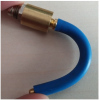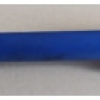Contact flexible temperature sensor
Technology description
| The name of the technology: | Contact flexible temperature sensor |
|---|---|
| Challenge: | Technical products are mainly cyclically loaded and heat up enormously. With respect to the type of product material, the intensity of heating varies. As the heat increases, the product material degrades faster. Therefore, it is necessary to know exactly the heating values of the material from which the product is made. Currently, heating analysis can be carried out using non-contact infrared sensors, but this method is demanding in terms of analysis conditions and if these are not met, the measured values may be completely erroneous. An accurate method is contact measurement, but this again cannot be performed on cyclically loaded material because there is no sensor capable of deforming with the deformation of the material being measured. Therefore, the presented technical solution concerns a contact flexible sensor for continuous temperature measurements on the surfaces of samples where the position or geometry of the analysed object changes over time due to an external force. |
| Description: |
According to the technical design, the contact flexible temperature sensor is useful for measuring the temperature on the external or internal surfaces of bodies where the position or geometry of the analysed object changes over time due to an external force. The most important advantage of this sensor is its high flexibility, where it is able to achieve significant deformations at high loading frequencies. Therefore, this sensor is unique for temperature analysis on the surface of materials that are loaded with very high deformations as well as loading frequency. This sensor is then preferably used in the testing industry for dynamic resistance tests of materials under combined thermal-mechanical stresses. This solution eliminates the disadvantage of standard contact sensors that they are only able to measure the temperature of the surface of a body that is unchanging in terms of position and geometry of the analysed object, since a change in position or geometry would mean a loss of contact between the sensor and the surface to be measured, while the presented technical solution offers a constant contact force even if the geometry or position of the analysed body changes. Currently, contact temperature sensors with a flexible carrier and a contact end member are on the market, where they are thermocouple temperature sensors with a cable and a plastic housing, but where the plastic housing fails under cyclic dynamic loading and undergoes plastic deformation under high loads. This is remedied by the proposed solution, where a flexible rubber housing ensures high durability without cracking under both cyclic dynamic and static loading. In addition, even under high loads there is no plastic deformation and the material is resistant to thermal degradation. Another advantage of this solution is that the measured signal is transmitted through wires and therefore no signal loss can occur compared to a wireless connection. |
| Commercial opportunity: |
The Flexible Temperature Sensor is designed for accurate continuous analysis of the surface temperature of products, components, parts, equipment, bodies, processes, test materials, etc. when they change their position or geometry over time due to external forces or kinematic changes. The sensor is used in the analysis of surface temperatures of highly cyclical dynamically loaded components such as shock absorbers, thick-blocks or in the analysis of process temperatures, when the process involves movement or change of position of individual process components, the advantage of this solution is that it is able to continuously analyze temperatures even with very rapid change of position. The sensor is particularly suitable for industrial applications as well as for testing. This type of sensor represents a completely new solution, which is not available on the market so far, precisely because of its ability to perform long-term analysis at high strain values as well as load frequencies. The proposed technology is very simple to manufacture, as it is assembled mostly from commercially available and simple components, and can therefore be produced industrially in large batches. The implementation and use of the proposed technical solution will allow for the first time to measure the temperature evolution in applications where it was previously possible to use only non-contact temperature sensors and therefore it will be possible to significantly increase the accuracy of the measured data. |
| IP protection status: | Utility model CZ 36874, Invention application pending in CZ |
| Development status: |
Phase 3Corresponds with TRL 5 and TRL 6 Technology validation and implementing it in real environment. Testing the technology outside of the laboratory and its adjustment to external conditions.
|
| Partnering strategy: | Collaboration licensing |
| More information: | |
| Images: | |
| Categories: | Chemistry Chemical and bioengineering |
| Institution: | Tomas Bata University in Zlín |
| Owner of a technology: | Univerzita Tomáše Bati ve Zlíně |

